Gina smith room - Study guides, Class notes & Summaries
Looking for the best study guides, study notes and summaries about Gina smith room? On this page you'll find 27 study documents about Gina smith room.
Page 2 out of 27 results
Sort by
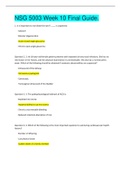
-
NSG 5003 Week 10 Final Guide.
- Summary • 53 pages • 2021
-
 abram23
abram23
-
- $16.19
- + learn more
NSG 5003 Week 10 Final Guide. 1. It is important to not dilate the eye if ____ is suspected. Cataract Macular degeneration Acute closed-angle glaucoma Chronic open-angle glaucoma Question 2. 2. An 18-year-old female patient presents with repeated urinary tract infections. She has no risk factors in her history, and her physical examination is unremarkable. She also has a normal pelvic exam. Which of the following should be obtained if anatomic abnormalities are suspected? Ultra...
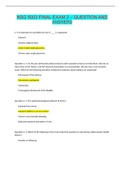
-
NSG 5003 FINAL EXAM 2 – QUESTION AND ANSWERS (Graded A+) LATEST UPDATE
- Exam (elaborations) • 53 pages • 2021
-
 TestGen
TestGen
-
- $15.99
- + learn more
NSG 5003 FINAL EXAM 2 – QUESTION AND ANSWERS 1. It is important to not dilate the eye if ____ is suspected. Cataract Macular degeneration Acute closed-angle glaucoma Chronic open-angle glaucoma Question 2. 2. An 18-year-old female patient presents with repeated urinary tract infections. She has no risk factors in her history, and her physical examination is unremarkable. She also has a normal pelvic exam. Which of the following should be obtained if anat...
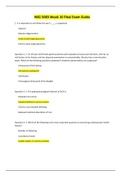
-
NSG 5003 Week 10 Final Exam Guide (193 Questions with Correct Answers) Guaranteed A Grade
- Exam (elaborations) • 53 pages • 2021
- Available in package deal
-
 Bri254
Bri254
-
- $25.49
- + learn more
NSG 5003 Week 10 Final Exam Guide 1. It is important to not dilate the eye if ____ is suspected. Question 2. 2. An 18-year-old female patient presents with repeated urinary tract infections. She has no risk factors in her history, and her physical examination is unremarkable. She also has a normal pelvic exam. Which of the following should be obtained if anatomic abnormalities are suspected? Question 3. 3. The pathophysiological hallmark of ACD is: Question 4. 4. Which of the followin...
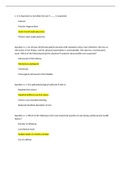
-
NSG 5003 Week 11 Final Exam 2.100% correct
- Exam (elaborations) • 53 pages • 2021
-
 Expert101
Expert101
-
- $43.49
- + learn more
NSG 5003 Final Exam 1. It is important to not dilate the eye if ____ is suspected. 2. An 18-year-old female patient presents with repeated urinary tract infections. She has no risk factors in her history, and her physical examination is unremarkable. She also has a normal pelvic exam. Which of the following should be obtained if anatomic abnormalities are suspected? 3. The pathophysiological hallmark of ACD is: 4. Which of the following is the most important...
![NSG5003 FAMILY NUR|FAMILY NURNSG5003 Week 10 Final Guide 2020/2021...[Recent]](/docpics/5f58a55c7eb76_815588.jpg)
-
NSG5003 FAMILY NUR|FAMILY NURNSG5003 Week 10 Final Guide 2020/2021...[Recent]
- Study guide • 53 pages • 2020
-
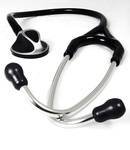 grade_bender
grade_bender
-
- $11.39
- 1x sold
- + learn more
FAMILY NUR NSG5003 Week 10 Final Guide 1. It is important to not dilate the eye if ____ is suspected. Question 2. 2. An 18-year-old female patient presents with repeated urinary tract infections. She has no risk factors in her history, and her physical examination is unremarkable. She also has a normal pelvic exam. Which of the following should be obtained if anatomic abnormalities are suspected? Question 3. 3. The pathophysiological hallmark of ACD is: Question 4...
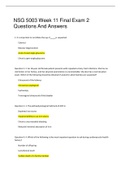
-
NSG 5003 Week 11 Final Exam 2 Questions And Answers
- Exam (elaborations) • 54 pages • 2021
-
 Dianamusenjeli
Dianamusenjeli
-
- $20.49
- + learn more
NSG 5003 Final Exam 1. It is important to not dilate the eye if ____ is suspected. 2. An 18-year-old female patient presents with repeated urinary tract infections. She has no risk f actors in her history, and her physical examination is unremarkable. She also has a normal pelvic exam. Which of the following should be obtained if anatomic abnormalities are suspected? 3. The pathophysiological hallmark of ACD is: 4. Which of the following is the most important question to ask during cardiovascula...

-
NCLEX Leadership Questions (300 Questions and Answers)
- Exam (elaborations) • 67 pages • 2021
-
 Academictutor
Academictutor
-
- $20.99
- + learn more
NCLEX Leadership Questions and Answers NCLEX Leadership Questions: 300 1. An agitated, confused female client arrives in the emergency department. Her history includes type 1 diabetes mellitus, hypertension, and angina pectoris. Assessment reveals pallor, diaphoresis, headache, and intense hunger. A stat blood glucose sample measures 42 mg/dl, and the client is treated for an acute hypoglycemic reaction. After recovery, the nurse teaches the client to treat hypoglycemia by ingesting: ...
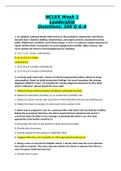
-
NCLEX Week 1 Leadership Questions: 300 Q & A
- Exam (elaborations) • 68 pages • 2021
-
 Cowell
Cowell
-
- $16.49
- + learn more
NCLEX Week 1 Leadership Questions: 300 Q & A 1. An agitated, confused female client arrives in the emergency department. Her history includes type 1 diabetes mellitus, hypertension, and angina pectoris. Assessment reveals pallor, diaphoresis, headache, and intense hunger. A stat blood glucose sample measures 42 mg/dl, and the client is treated for an acute hypoglycemic reaction. After recovery, the nurse teaches the client to treat hypoglycemia by ingesting: A. 2 to 5 g of a simple carbohydr...
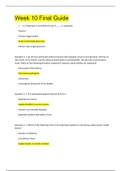
-
NSG 5003 Week 10 Final Guide / NSG 5003 Final Guide (Version-2, New, 2020): South University ( Correct Q & A) (SATISFACTION GUARANTEED.
- Study guide • 53 pages • 2020
-
 Succeed
Succeed
-
- $25.49
- + learn more
Week 10 Final Guide 1. It is important to not dilate the eye if ____ is suspected. Cataract Macular degeneration Acute closed-angle glaucoma Chronic open-angle glaucoma Question 2. 2. An 18-year-old female patient presents with repeated urinary tract infections. She has no risk factors in her history, and her physical examination is unremarkable. She also has a normal pelvic exam. Which of the following should be obtained if anatomic abnormalities are suspected? ...
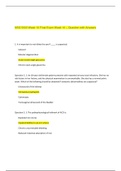
-
NSG 5003 FINAL EXAM 2 - Questions and Answers (latest 2020)
- Exam (elaborations) • 54 pages • 2021
-
 BestSellerStuvia
BestSellerStuvia
-
- $15.49
- + learn more
NSG 5003 Week 10 Final Exam Week 10 – Question with Answers It is important to not dilate the eye if ____ is suspected. An 18-year-old female patient presents with repeated urinary tract infections. She has no risk factors in her history, and her physical examination is unremarkable. She also has a normal pelvic exam. Which of the following should be obtained if anatomic abnormalities are suspected? The pathophysiological hallmark of ACD is: Which of the following is the most important questio...

$6.50 for your textbook summary multiplied by 100 fellow students... Do the math: that's a lot of money! Don't be a thief of your own wallet and start uploading yours now. Discover all about earning on Stuvia


